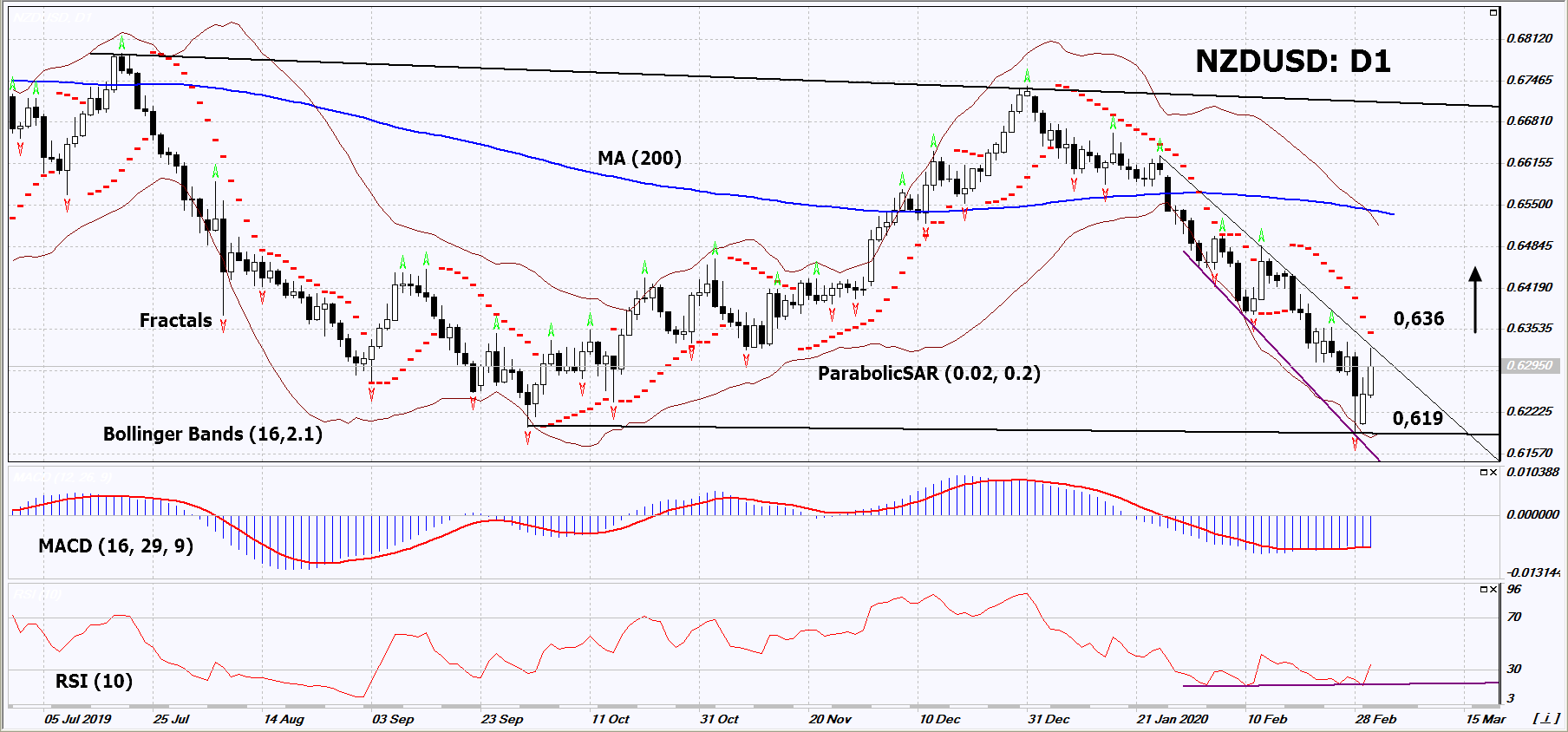- Analytics
- Technical Analysis
NZD USD Technical Analysis - NZD USD Trading: 2020-03-04
NZD/USD Technical Analysis Summary

Above 0.636
Buy Stop
Below 0.619
Stop Loss
| Indicator | Signal |
| RSI | Buy |
| MACD | Buy |
| Bollinger Bands | Buy |
| MA(200) | Neutral |
| Parabolic SAR | Sell |
| Fractals | Neutral |
NZD/USD Chart Analysis
NZD/USD Technical Analysis
On the daily timeframe, NZDUSD: D1 pushed off the support line of the medium-term neutral trend and is currently correcting upward. Now it has to overcome the resistance line of the short-term downtrend. Signals for a further increase were formed by a number of technical analysis indicators. We do not exclude bullish movement if NZDUSD rises above its last upper fractal, resistance line of short-term downtrend and Parabolic signal: 0.636. This level can be used as an entry point. The stop loss is feasible below the minimum since August 2015, the last lower fractal and the Bollinger Bottom Line: 0.619. After the opening the pending order, we move the stop loss after the signals of Bollinger and Parabolic to the next fractal minimum. So far, we switch the potential profit / loss ratio in our favor. After the transaction, the most risk-averse traders can switch to a four-hour chart and set a stop loss, moving it in the direction of the trend. If the price overcomes the stop level (0.619) without activating the order (0.636), it is recommended to cancel the order: markets sustain internal changes that weren’t taken into account.
Fundamental Analysis of Forex - NZD/USD
The US Federal Reserve cut the rate straightaway by 0.5% (from 1.75% to 1.25%). Will NZDUSD quotations grow?
The upward trend means strengthening of the New Zealand dollar against the US dollar. The Fed lowered the rate in order to support the US economy amid the coronavirus epidemic. For the same reason, the Reserve Bank of Australia also lowered its rate to a historic minimum of 0.5% from 0.75%. All these actions may support the New Zealand dollar. The Reserve Bank of New Zealand can also lower its rate at a meeting on March 25, which is 1% at present. A positive factor for the NZD is the increase in residential properties prices in New Zealand in February 2020, by 5.3% on an annualized basis. This is much higher than the annual inflation of 1.9%. The average cost of a house in New Zealand reached NZ $ 722.5 thousand ($ 452.4 thousand). Note that China is the main trading partner of New Zealand, so the exchange rate may depend on the state of not only the New Zealand, but also the Chinese economy. Worth mentioning that in 2019, foreign trade indicators were positive: the macroeconomic indicator, called New Zealand's terms of trade, increased by 7% in the 4th quarter compared to the same quarter of 2018.
Explore our
Trading Conditions
- Spreads from 0.0 pip
- 30,000+ Trading Instruments
- Instant Execution
Ready to Trade?
Open Account Note:
This overview has an informative and tutorial character and is published for free. All the data, included in the overview, are received from public sources, recognized as more or less reliable. Moreover, there is no guarantee that the indicated information is full and precise. Overviews are not updated. The whole information in each overview, including opinion, indicators, charts and anything else, is provided only for familiarization purposes and is not financial advice or а recommendation. The whole text and its any part, as well as the charts cannot be considered as an offer to make a deal with any asset. IFC Markets and its employees under any circumstances are not liable for any action taken by someone else during or after reading the overview.

